Abstract
OBJECTIVE: This study investigates the role of nonclinical factors (physician characteristics) in explaining variations in hysterectomy practice patterns. DATA SOURCES AND STUDY SETTING: Patient discharge data are obtained from the Arizona state discharge database for the years 1989-1991. Physician data are obtained from the Arizona State Medical Association. The analyses are based on 36,104 cases performed by 339 physicians in 43 hospitals. STUDY DESIGN: This article measures the impact of physician factors on the decision to perform a hysterectomy, controlling for a host of patient and hospital characteristics. Physician factors include background characteristics and training, medical experience, and physician's practice style. Physician effects are evaluated in terms of their overall contribution to the explanatory power of regression models, as well as in terms of specific hypotheses to be tested. DATA COLLECTION: The sources of data were linked to produce one record per patient. PRINCIPAL FINDINGS: As a set, physician factors account for a statistically significant increase in the explanatory power of the model after addition of patient and hospital effects. Parameter estimates provide further support for the hypothesized effects of physicians' background, experience, and practice characteristics. CONCLUSIONS: Overall, the results confirm that nonclinical (physician) factors play a statistically significant role in the hysterectomy decision. Substantively, however, these factors play a smaller, secondary role compared to that of clinical and patient factors in explaining practice variations in hysterectomies. The results suggest that efforts to reduce unnecessary hysterectomies should be directed at identifying the appropriate clinical indications for hysterectomy and disseminating this information to physicians and patients. This may require such intervention strategies as continuing clinical education, promulgation of explicit practice guidelines, peer review, public education, and greater understanding and inclusion of patient preference in the decision process.
Full text
PDF
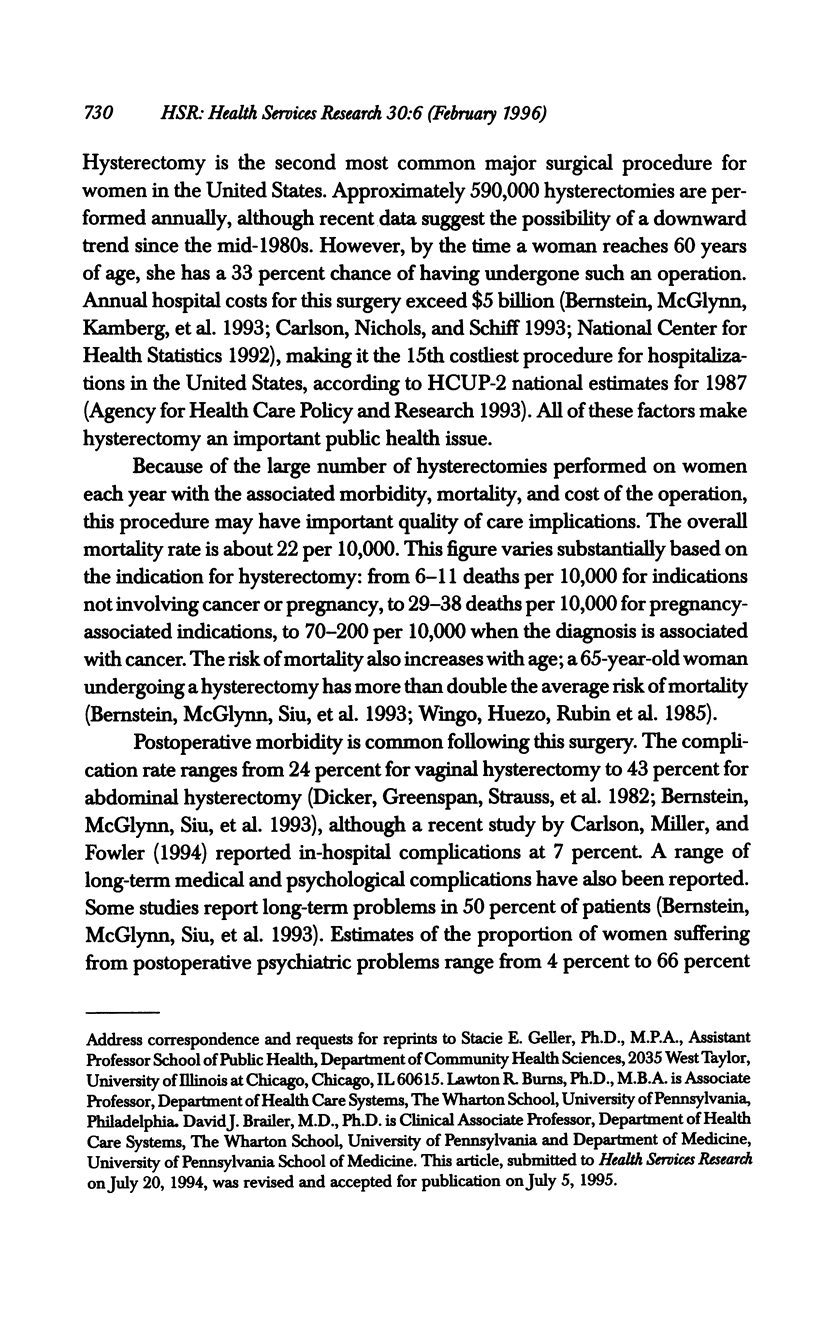
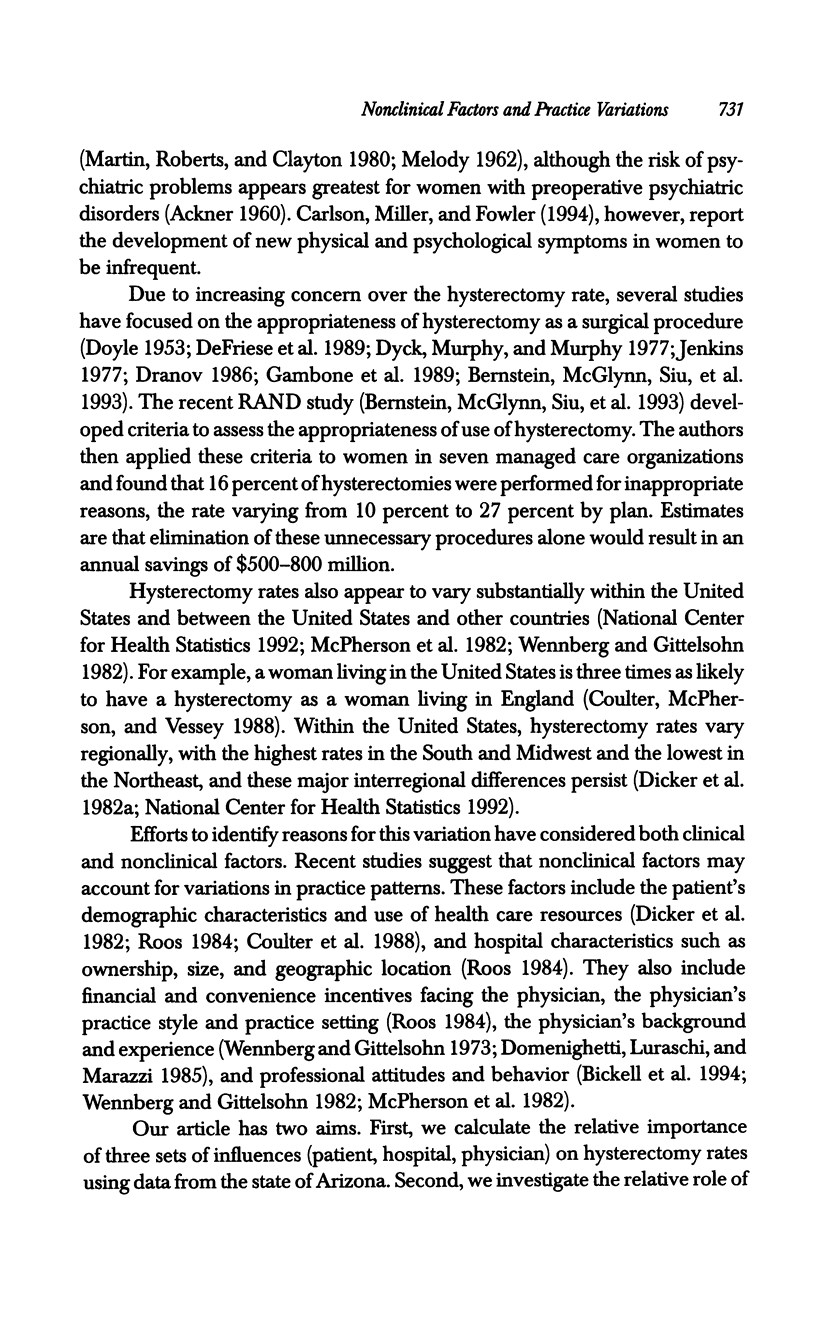
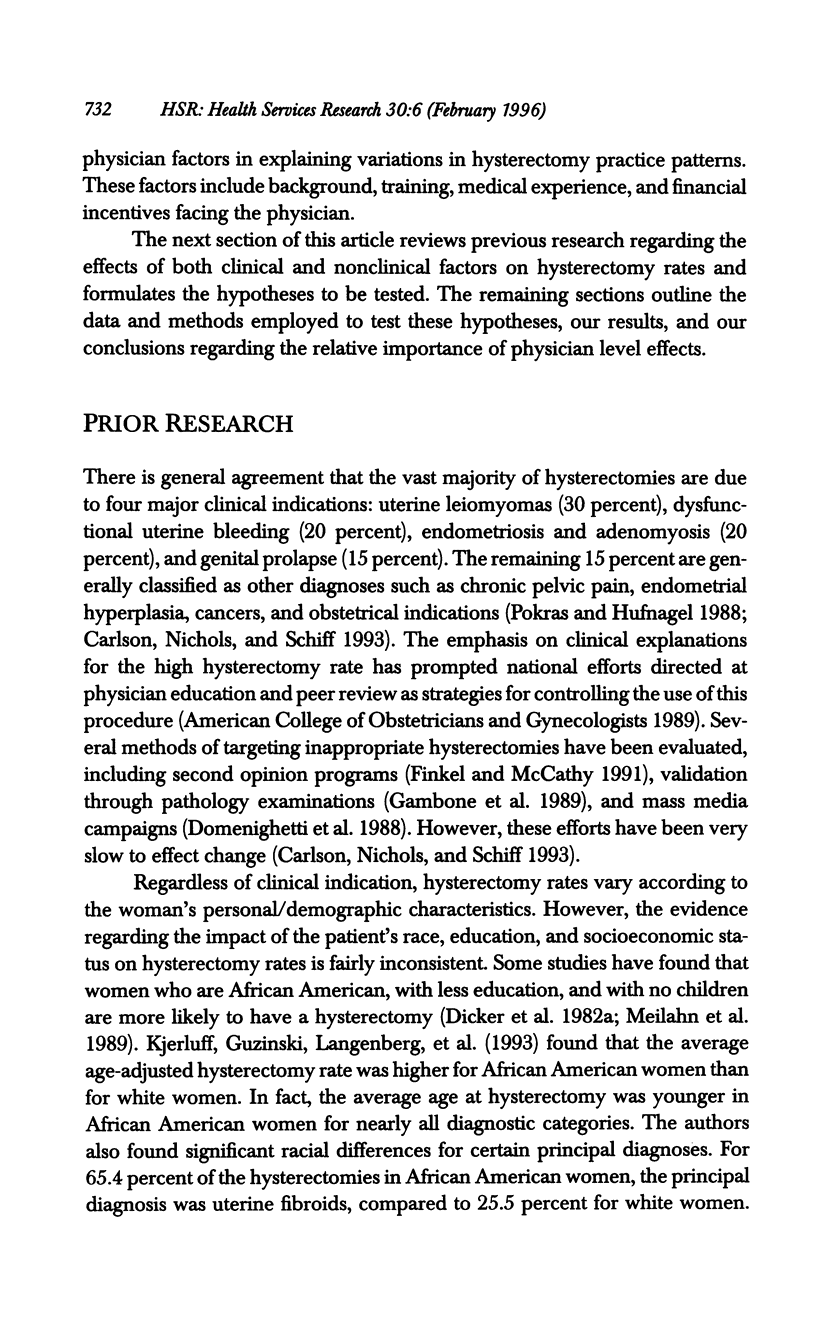
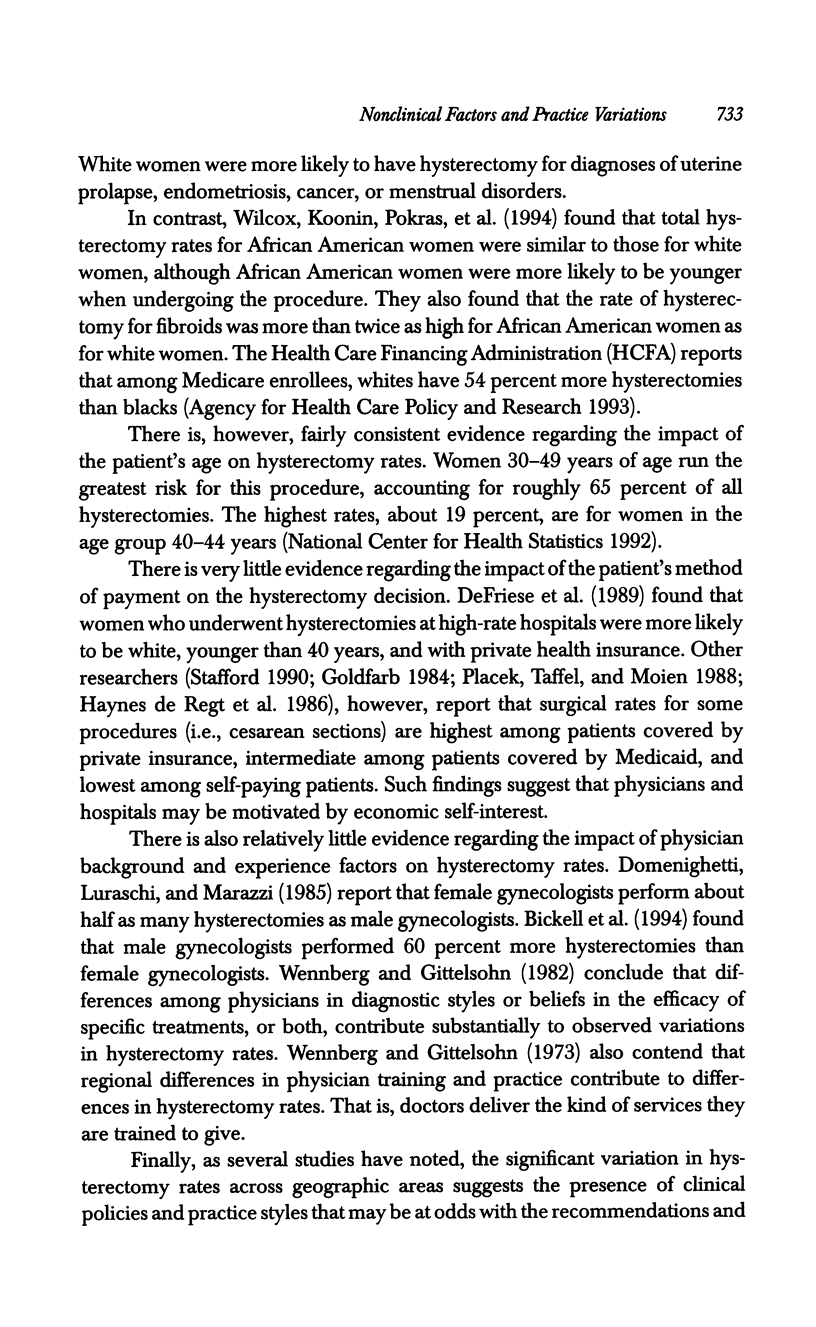
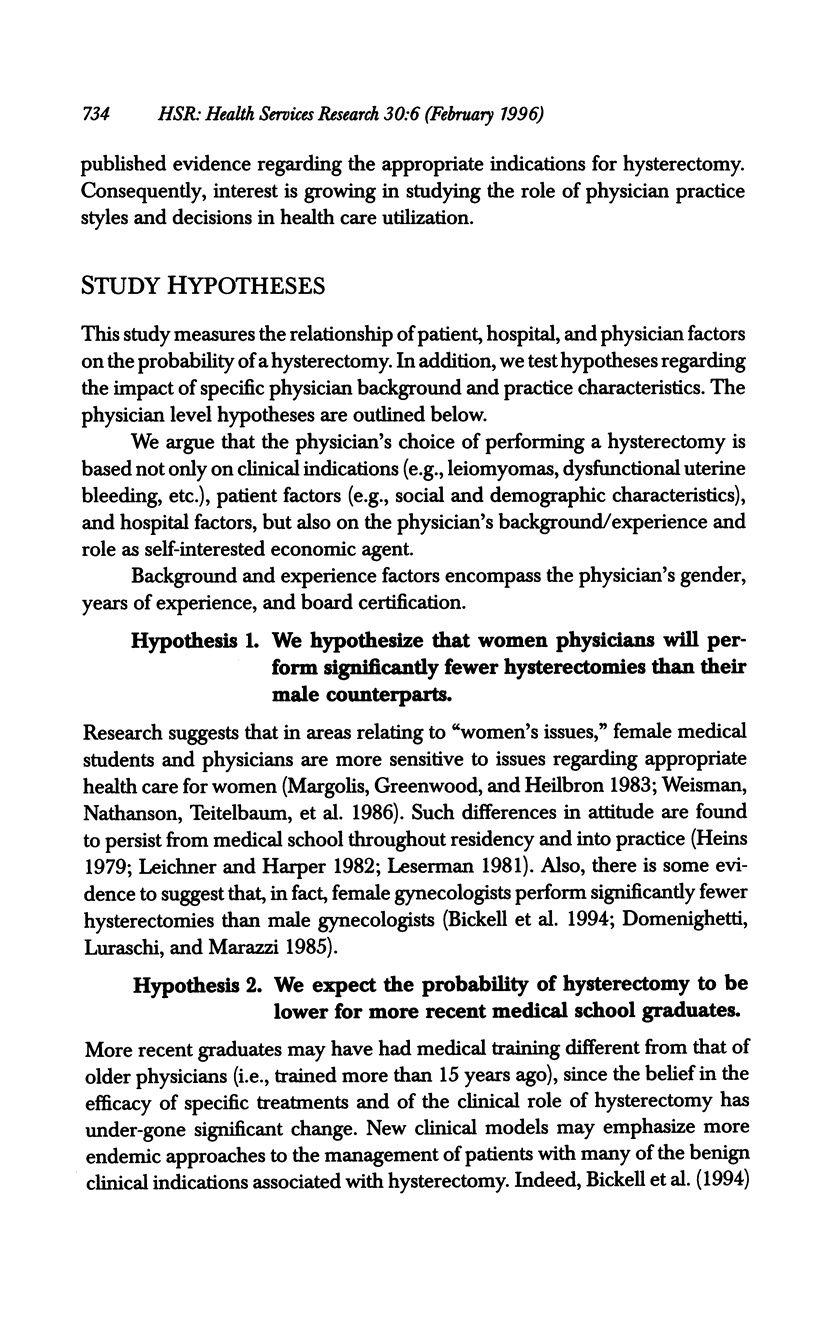
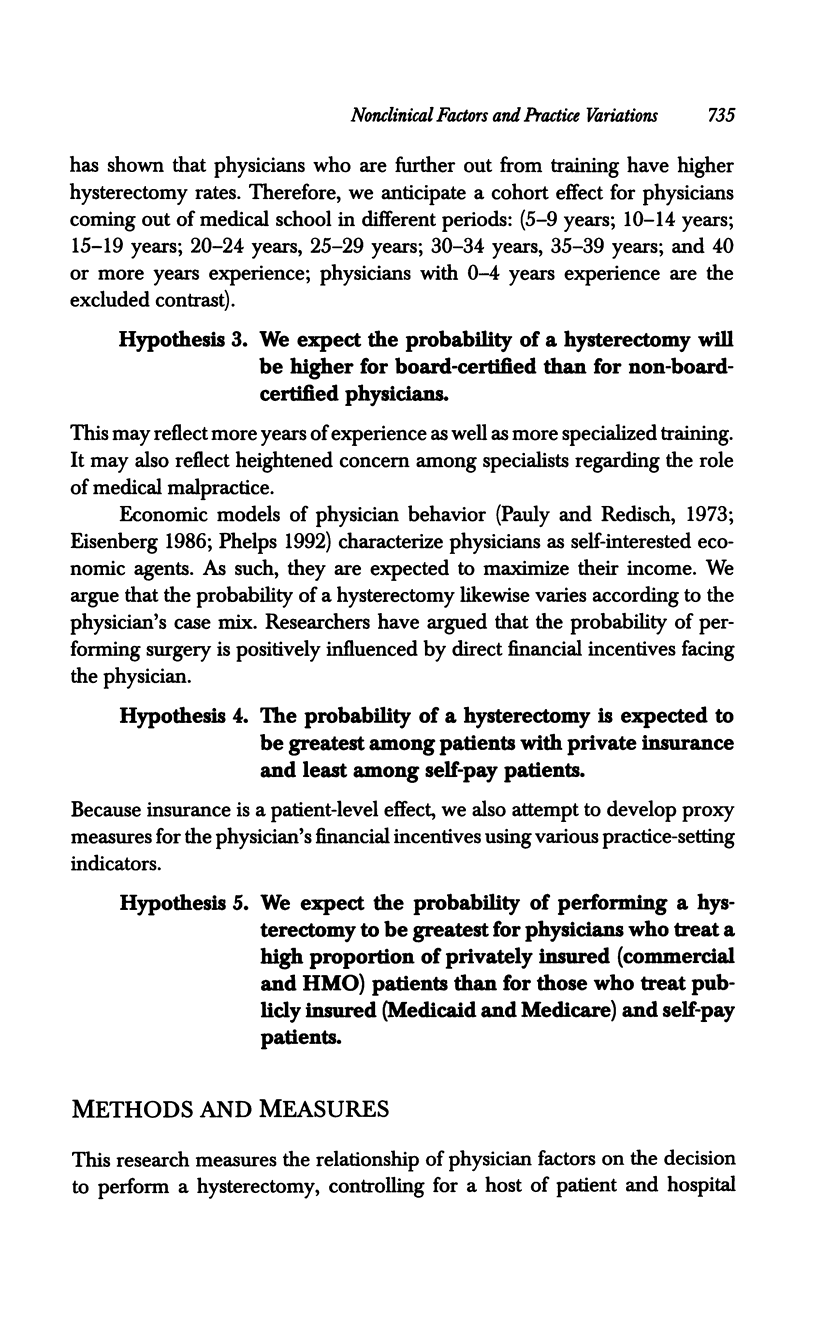
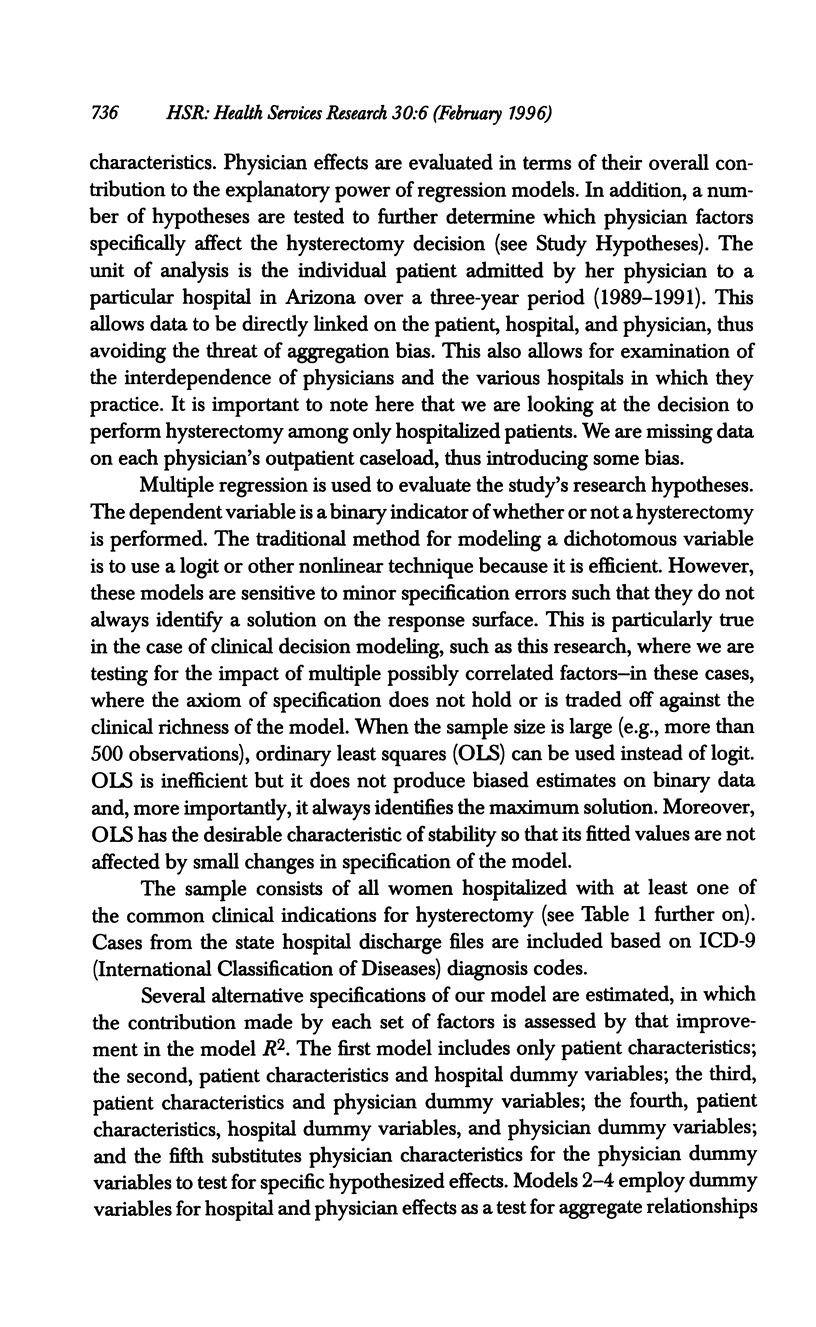
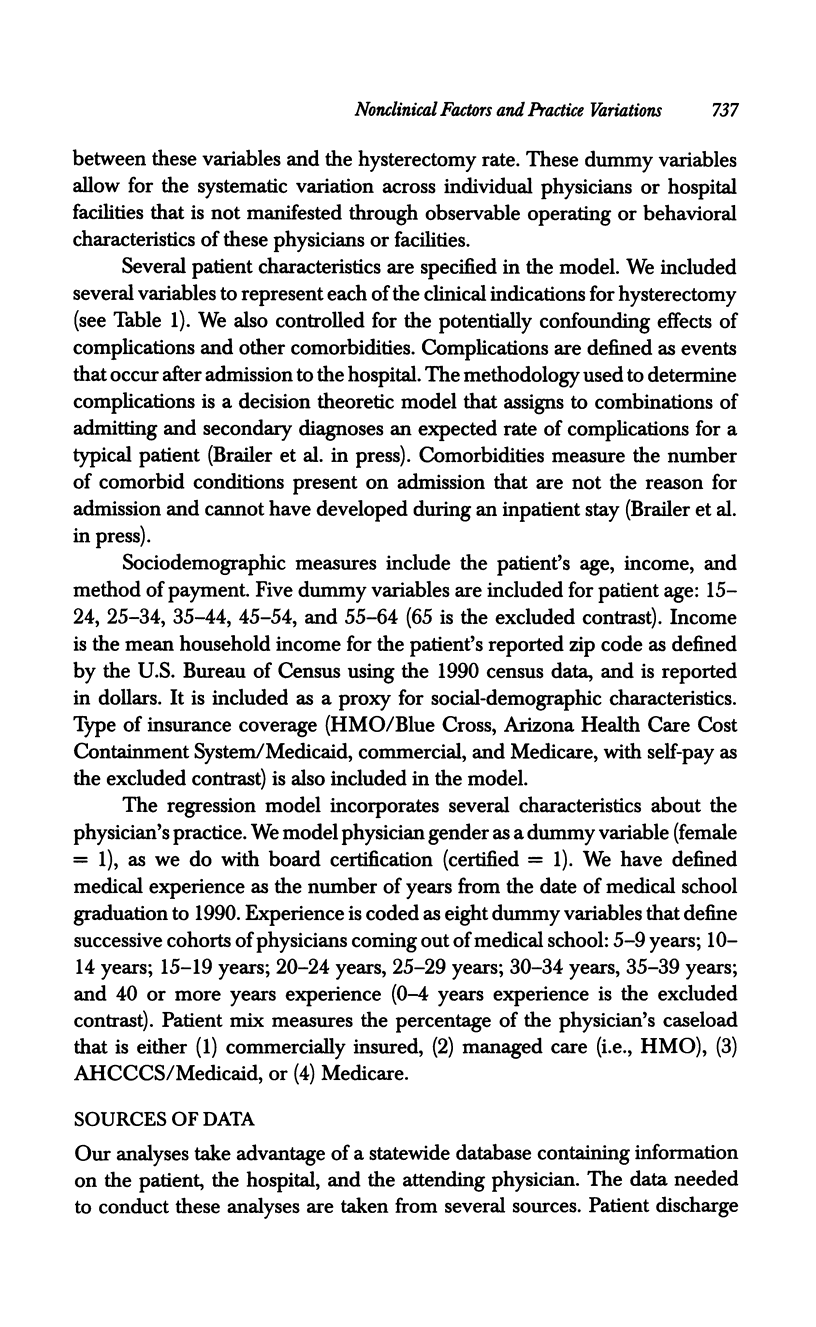
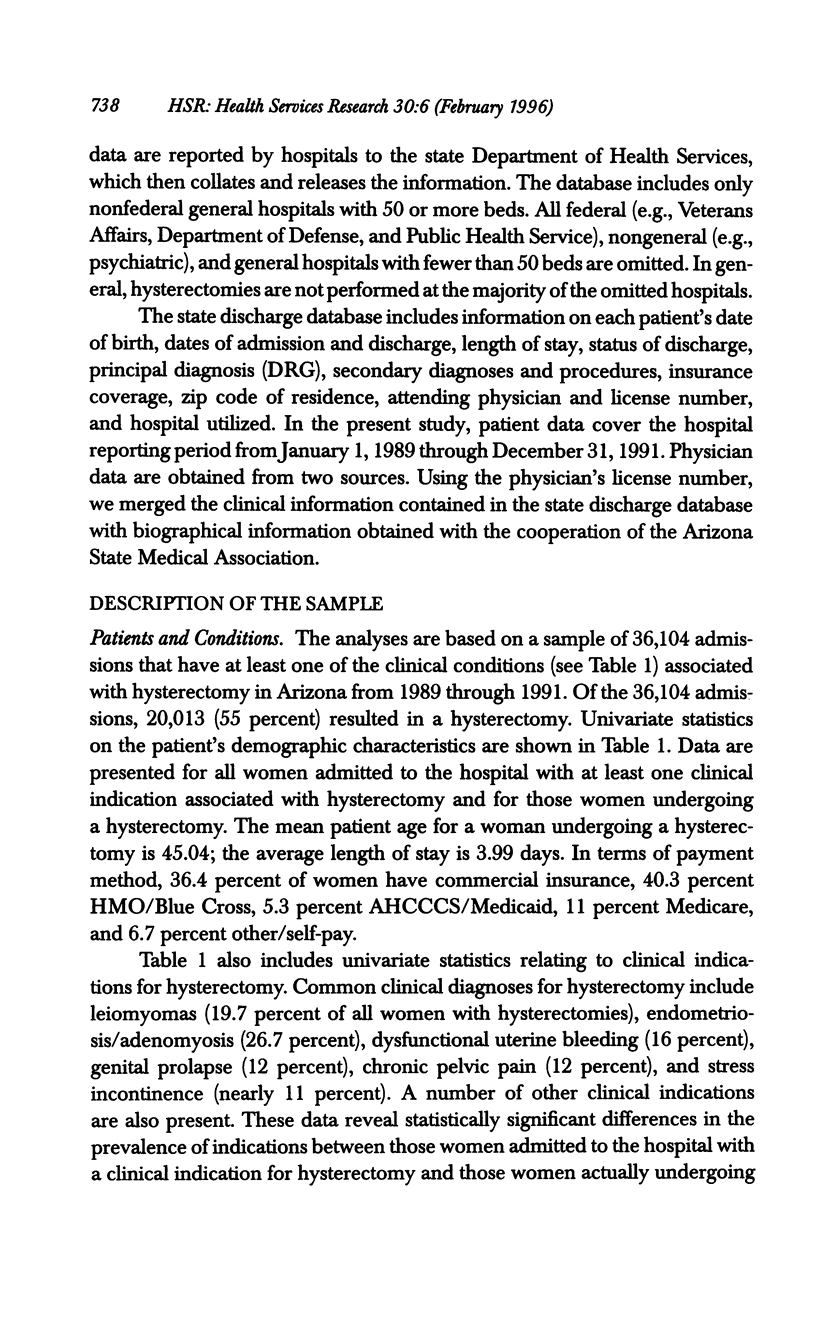
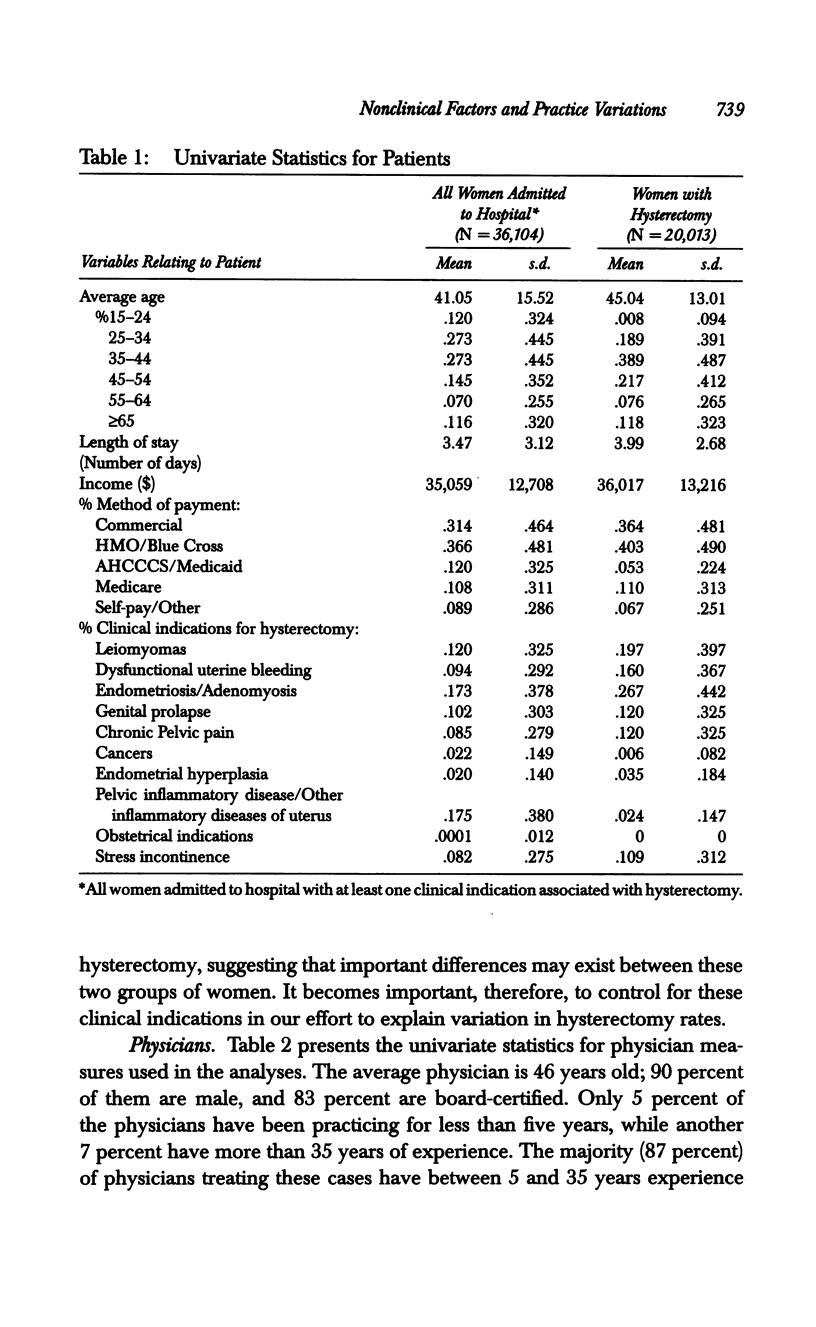
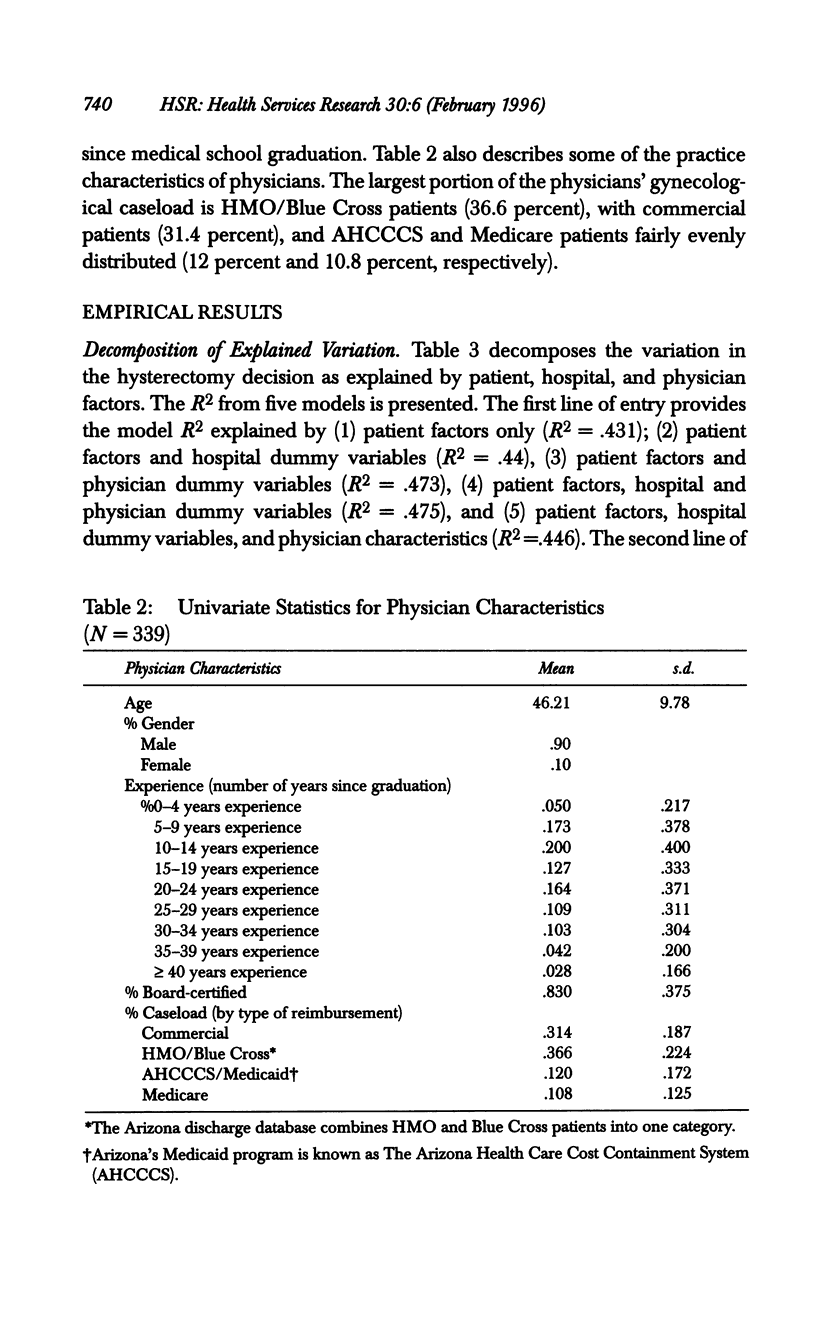
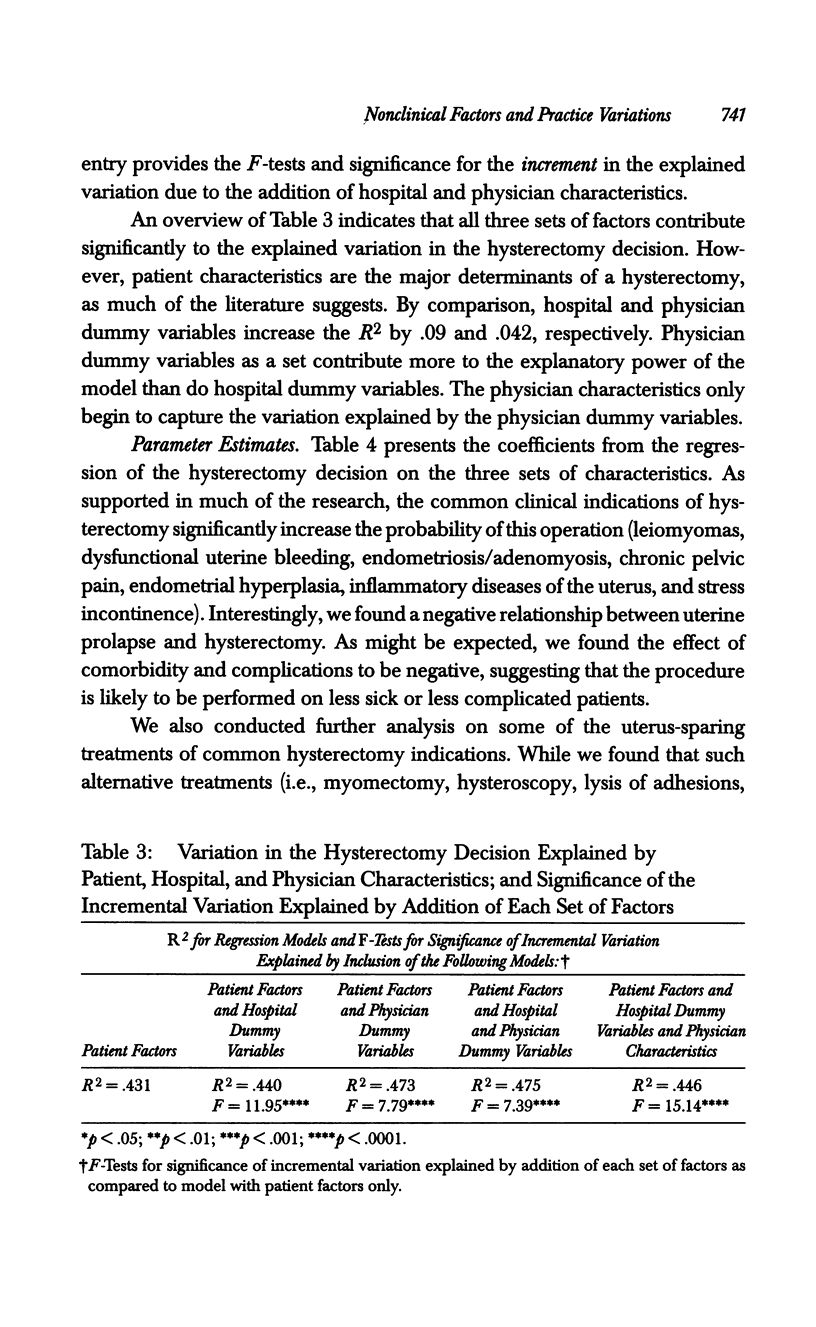
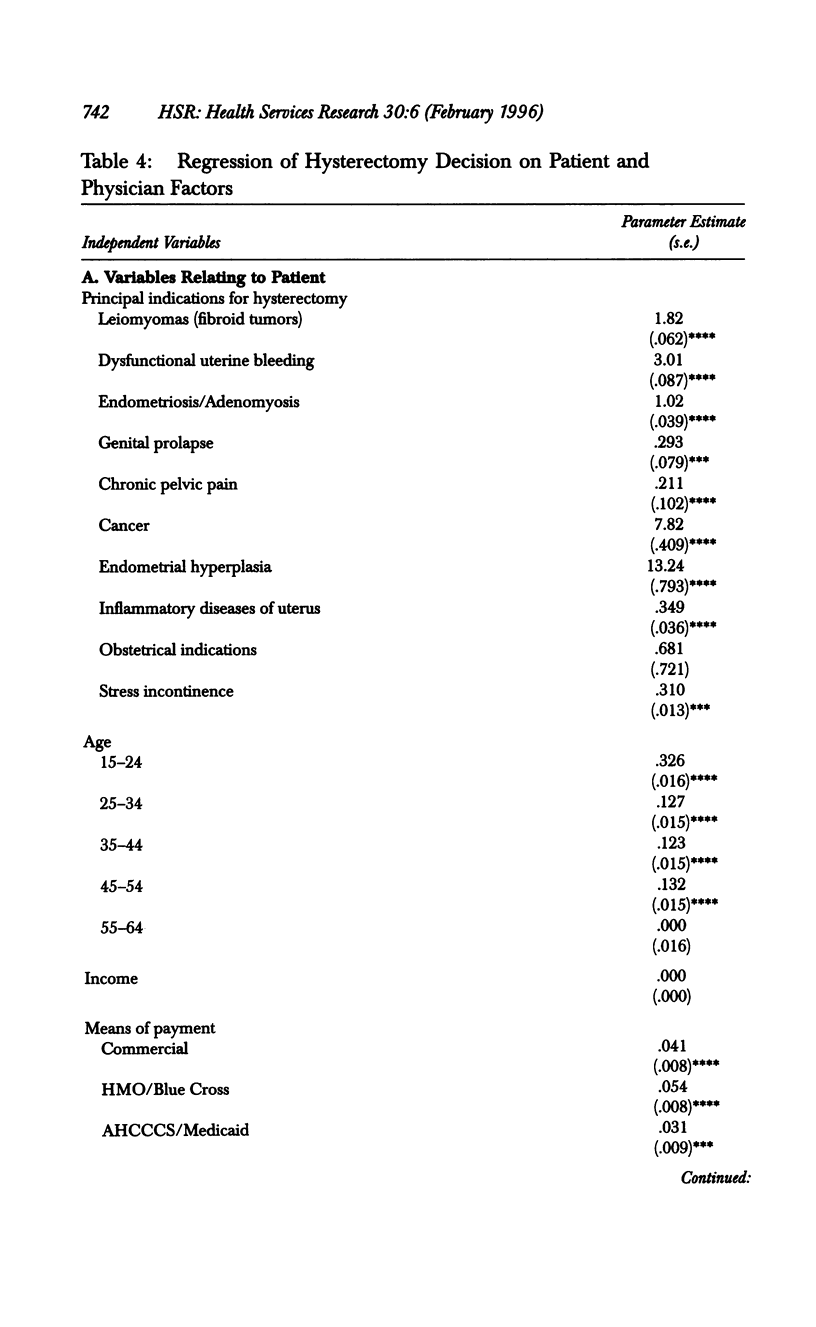
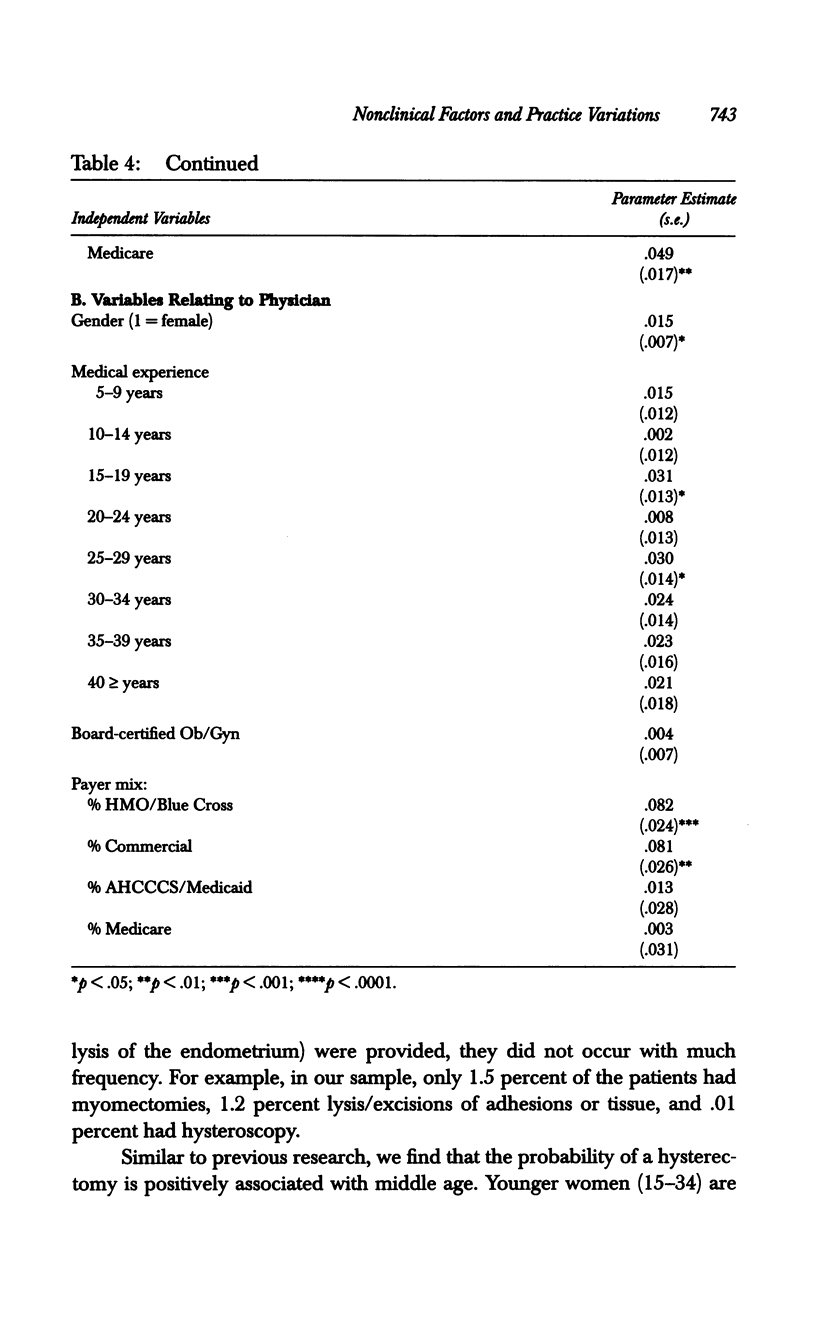
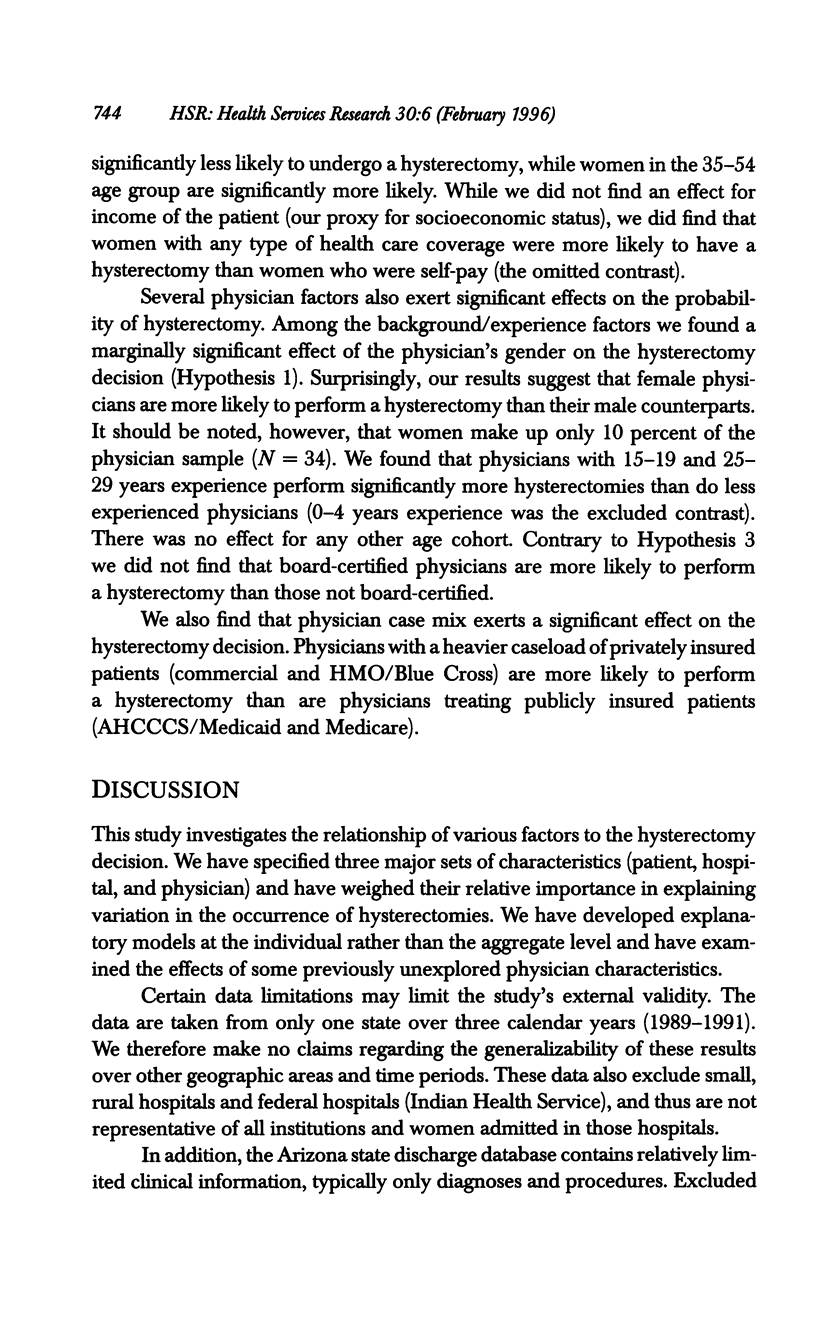
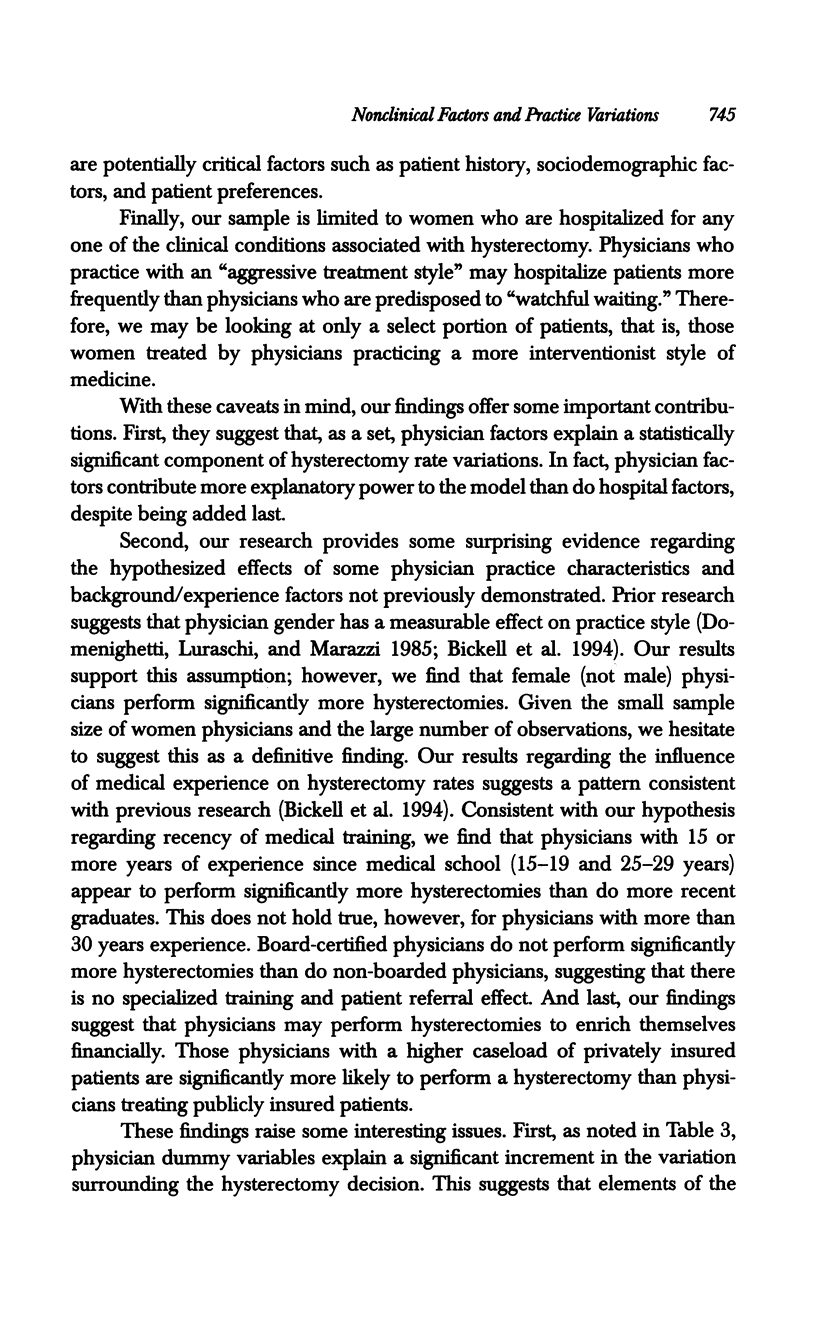
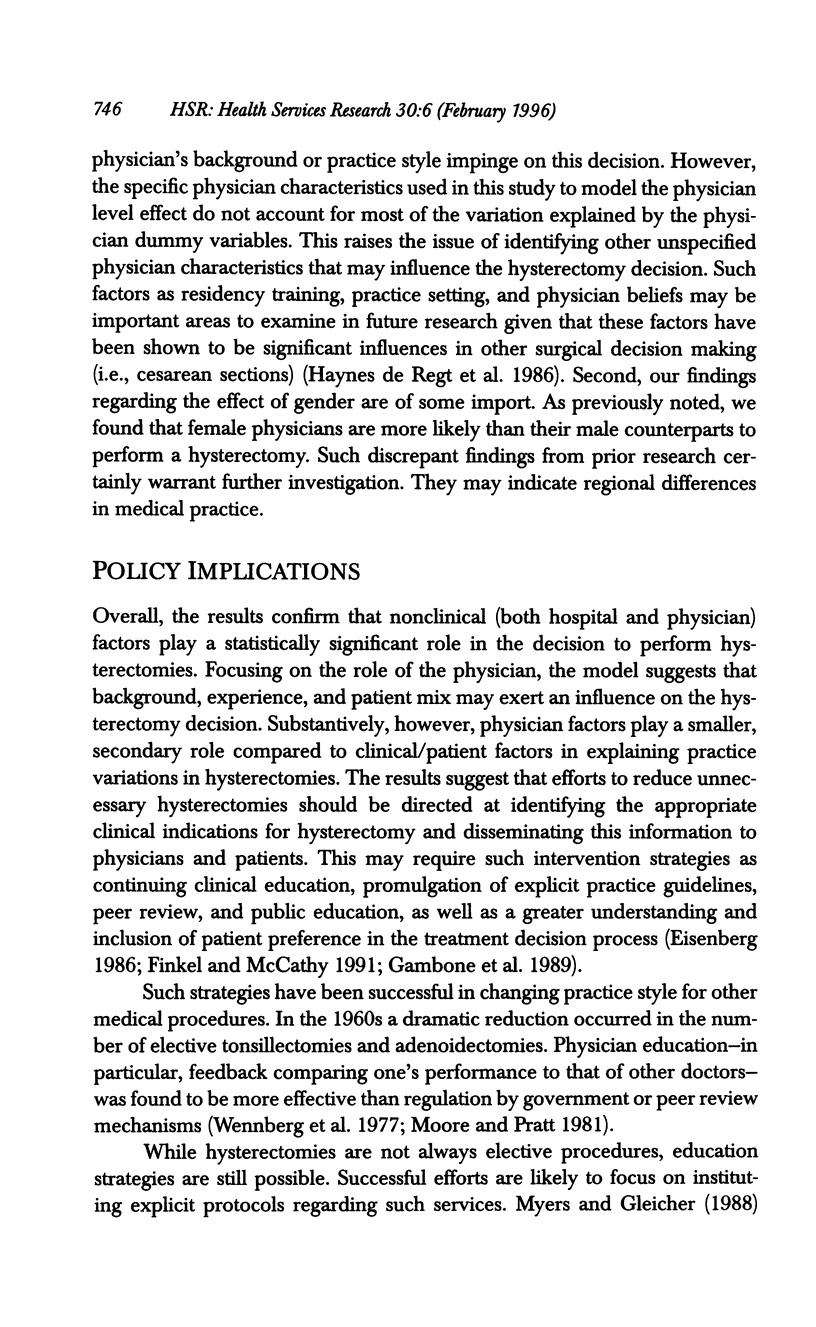
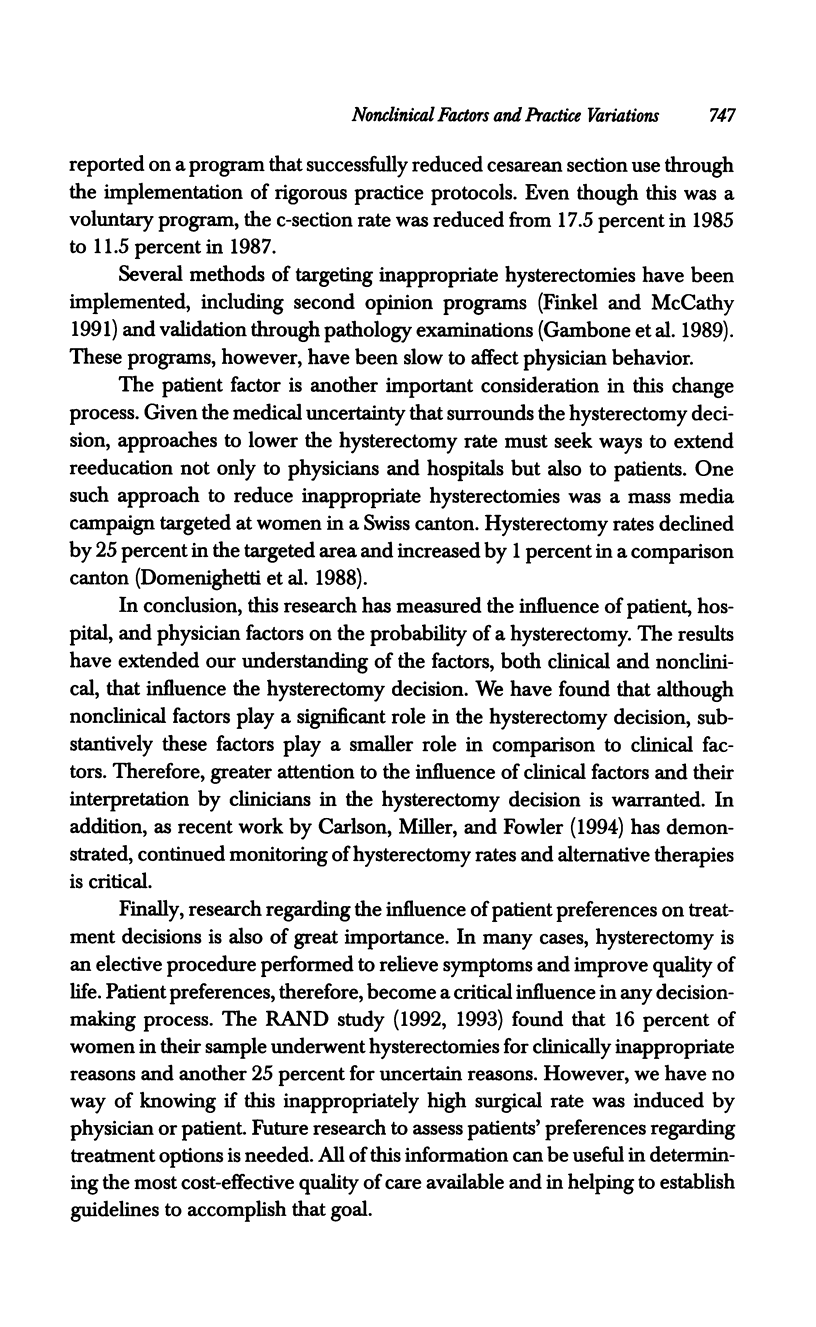
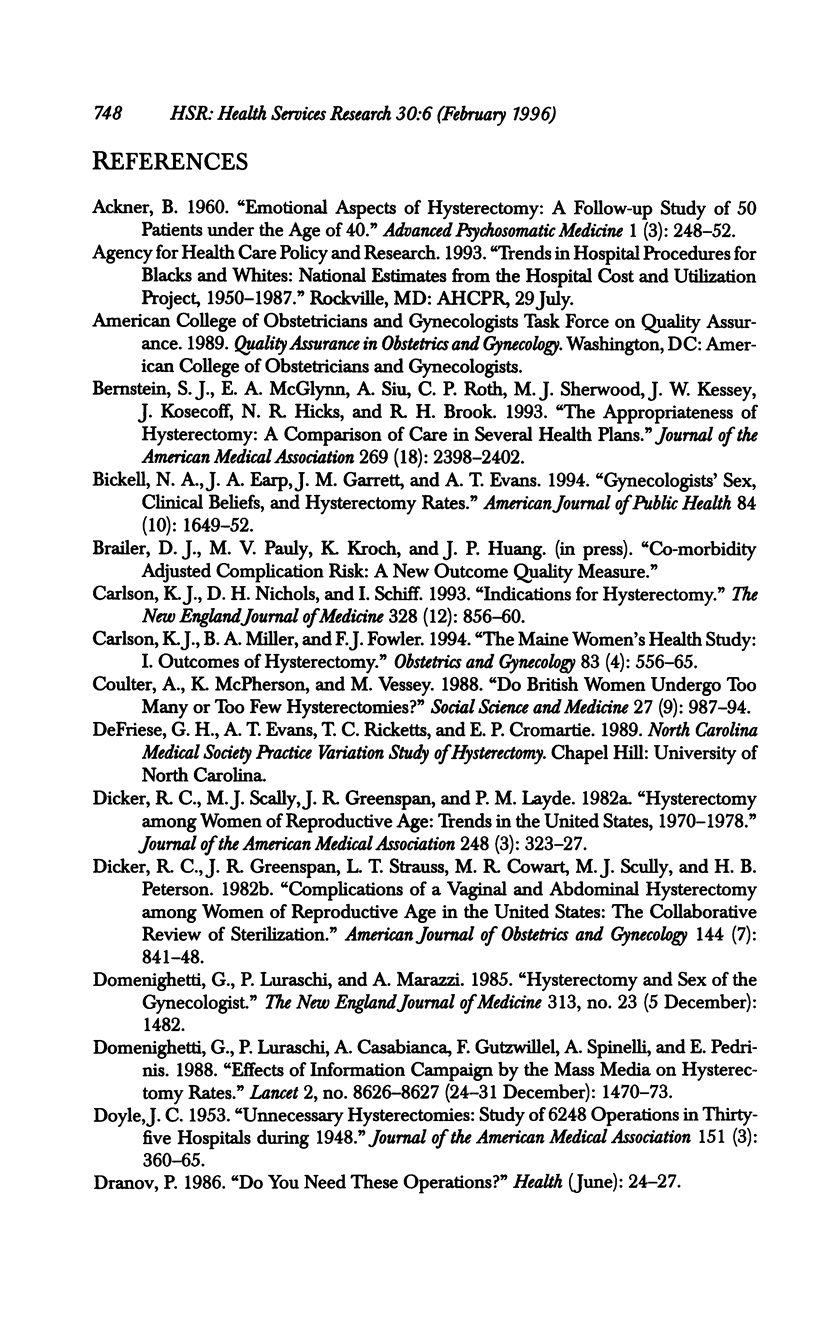
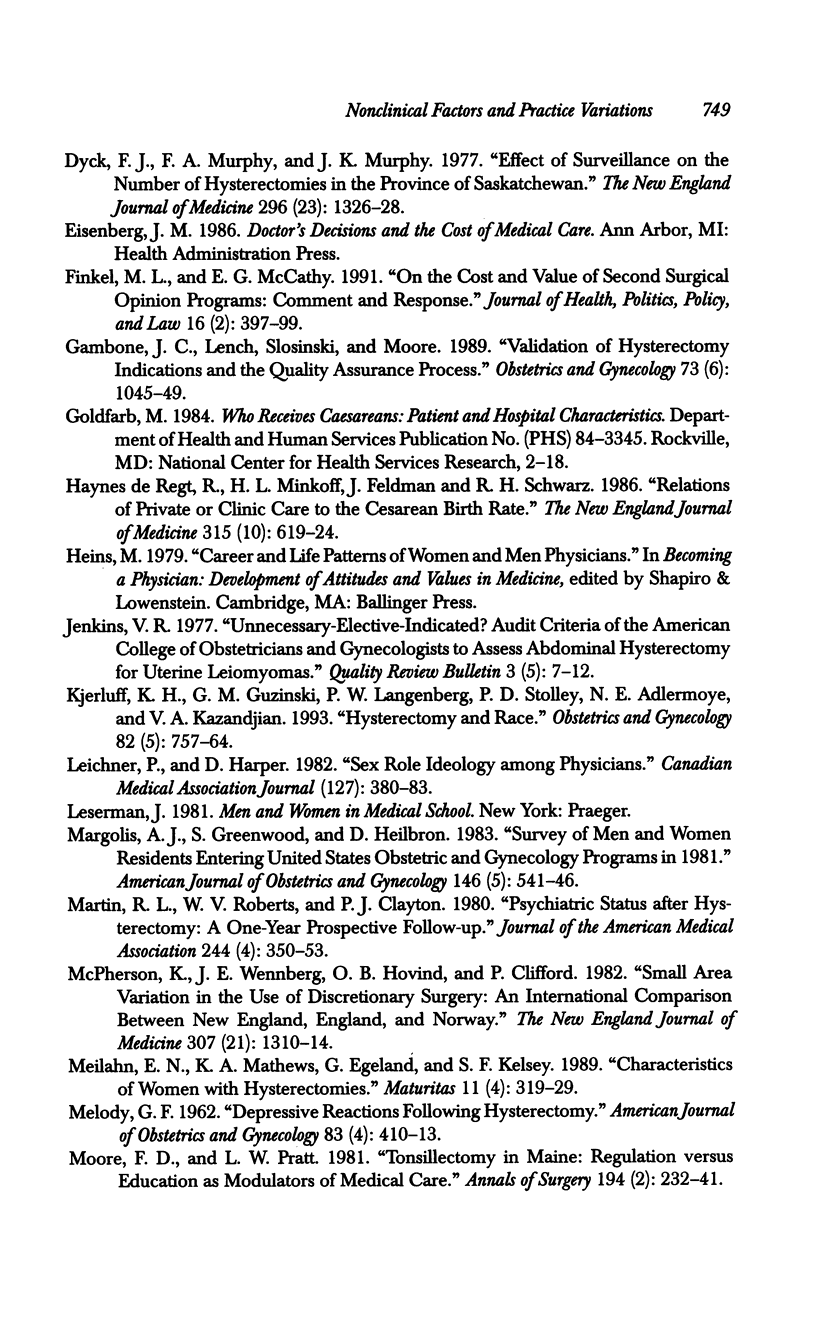
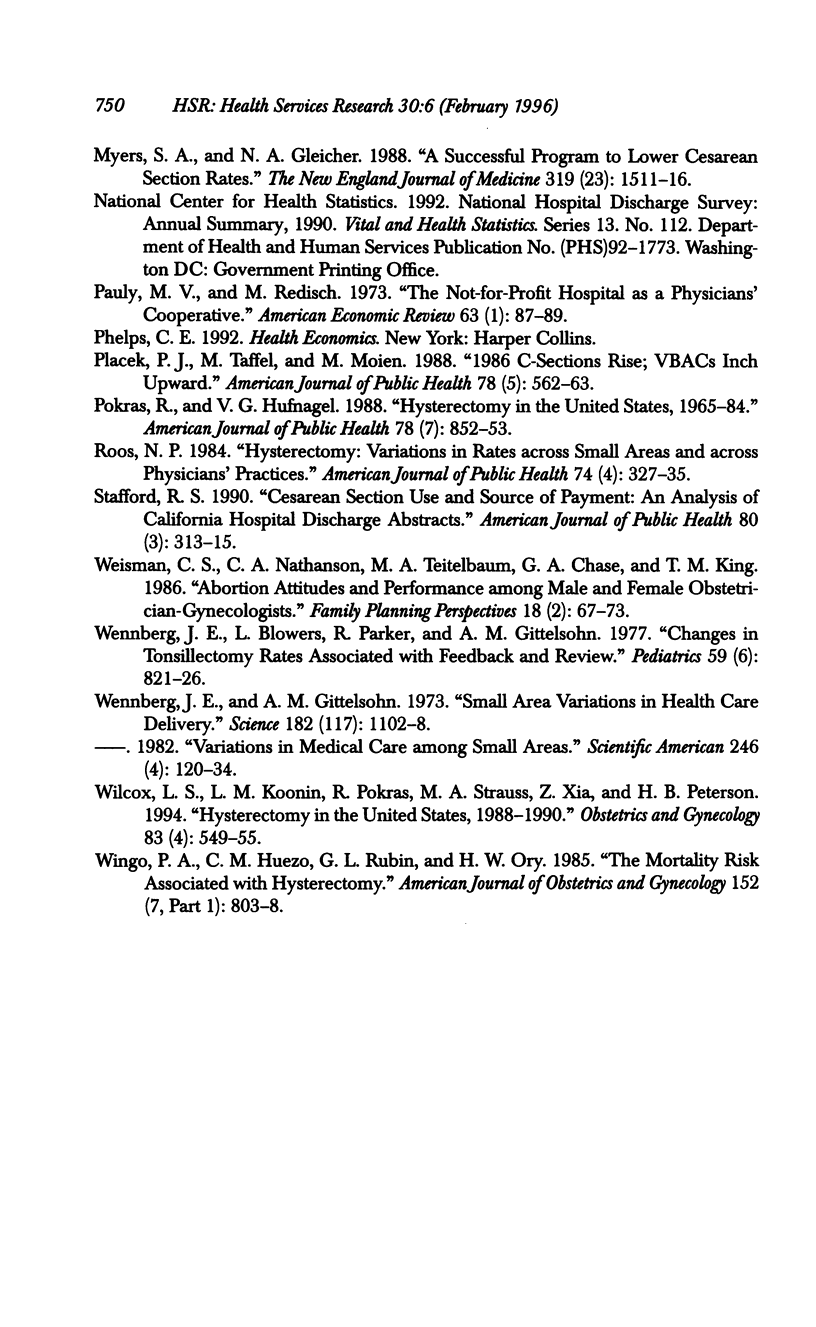
Selected References
These references are in PubMed. This may not be the complete list of references from this article.
- Bernstein S. J., McGlynn E. A., Siu A. L., Roth C. P., Sherwood M. J., Keesey J. W., Kosecoff J., Hicks N. R., Brook R. H. The appropriateness of hysterectomy. A comparison of care in seven health plans. Health Maintenance Organization Quality of Care Consortium. JAMA. 1993 May 12;269(18):2398–2402. doi: 10.1001/jama.269.18.2398. [DOI] [PubMed] [Google Scholar]
- Bickell N. A., Earp J. A., Garrett J. M., Evans A. T. Gynecologists' sex, clinical beliefs, and hysterectomy rates. Am J Public Health. 1994 Oct;84(10):1649–1652. doi: 10.2105/ajph.84.10.1649. [DOI] [PMC free article] [PubMed] [Google Scholar]
- Carlson K. J., Miller B. A., Fowler F. J., Jr The Maine Women's Health Study: I. Outcomes of hysterectomy. Obstet Gynecol. 1994 Apr;83(4):556–565. doi: 10.1097/00006250-199404000-00012. [DOI] [PubMed] [Google Scholar]
- Carlson K. J., Nichols D. H., Schiff I. Indications for hysterectomy. N Engl J Med. 1993 Mar 25;328(12):856–860. doi: 10.1056/NEJM199303253281207. [DOI] [PubMed] [Google Scholar]
- Coulter A., McPherson K., Vessey M. Do British women undergo too many or too few hysterectomies? Soc Sci Med. 1988;27(9):987–994. doi: 10.1016/0277-9536(88)90289-4. [DOI] [PubMed] [Google Scholar]
- DOYLE J. C. Unnecessary hysterectomies: study of 6,248 operations in thirty-five hospitals during 1948. J Am Med Assoc. 1953 Jan 31;151(5):360–365. [PubMed] [Google Scholar]
- Dicker R. C., Greenspan J. R., Strauss L. T., Cowart M. R., Scally M. J., Peterson H. B., DeStefano F., Rubin G. L., Ory H. W. Complications of abdominal and vaginal hysterectomy among women of reproductive age in the United States. The Collaborative Review of Sterilization. Am J Obstet Gynecol. 1982 Dec 1;144(7):841–848. doi: 10.1016/0002-9378(82)90362-3. [DOI] [PubMed] [Google Scholar]
- Dicker R. C., Scally M. J., Greenspan J. R., Layde P. M., Ory H. W., Maze J. M., Smith J. C. Hysterectomy among women of reproductive age. Trends in the United States, 1970-1978. JAMA. 1982 Jul 16;248(3):323–327. [PubMed] [Google Scholar]
- Domenighetti G., Luraschi P., Casabianca A., Gutzwiller F., Spinelli A., Pedrinis E., Repetto F. Effect of information campaign by the mass media on hysterectomy rates. Lancet. 1988 Dec 24;2(8626-8627):1470–1473. doi: 10.1016/s0140-6736(88)90943-9. [DOI] [PubMed] [Google Scholar]
- Domenighetti G., Luraschi P., Marazzi A. Hysterectomy and sex of the gynecologist. N Engl J Med. 1985 Dec 5;313(23):1482–1482. doi: 10.1056/NEJM198512053132320. [DOI] [PubMed] [Google Scholar]
- Dyck F. J., Murphy F. A., Murphy J. K., Road D. A., Boyd M. S., Osborne E., De Vlieger D., Korchinski B., Ripley C., Bromley A. T. Effect of surveillance on the number of hysterectomies in the province of Saskatchewan. N Engl J Med. 1977 Jun 9;296(23):1326–1328. doi: 10.1056/NEJM197706092962306. [DOI] [PubMed] [Google Scholar]
- Finkel M. L., McCathy E. G. On the cost and value of second surgical opinion programs: comment and response. J Health Polit Policy Law. 1991 Summer;16(2):397–399. doi: 10.1215/03616878-16-2-397. [DOI] [PubMed] [Google Scholar]
- Gambone J. C., Lench J. B., Slesinski M. J., Reiter R. C., Moore J. G. Validation of hysterectomy indications and the quality assurance process. Obstet Gynecol. 1989 Jun;73(6):1045–1049. doi: 10.1097/00006250-198906000-00028. [DOI] [PubMed] [Google Scholar]
- Kjerulff K. H., Guzinski G. M., Langenberg P. W., Stolley P. D., Moye N. E., Kazandjian V. A. Hysterectomy and race. Obstet Gynecol. 1993 Nov;82(5):757–764. [PubMed] [Google Scholar]
- Leichner P., Harper D. Sex role ideology among physicians. Can Med Assoc J. 1982 Sep 1;127(5):380–383. [PMC free article] [PubMed] [Google Scholar]
- MELODY G. F. Depressive reactions following hysterectomy. Am J Obstet Gynecol. 1962 Feb 1;83:410–413. doi: 10.1016/s0002-9378(16)35850-1. [DOI] [PubMed] [Google Scholar]
- Margolis A. J., Greenwood S., Heilbron D. Survey of men and women residents entering United States obstetrics and gynecology programs in 1981. Am J Obstet Gynecol. 1983 Jul 1;146(5):541–546. doi: 10.1016/0002-9378(83)90798-6. [DOI] [PubMed] [Google Scholar]
- Martin R. L., Roberts W. V., Clayton P. J. Psychiatric status after hysterectomy. A one-year prospective follow-up. JAMA. 1980 Jul 25;244(4):350–353. [PubMed] [Google Scholar]
- McPherson K., Wennberg J. E., Hovind O. B., Clifford P. Small-area variations in the use of common surgical procedures: an international comparison of New England, England, and Norway. N Engl J Med. 1982 Nov 18;307(21):1310–1314. doi: 10.1056/NEJM198211183072104. [DOI] [PubMed] [Google Scholar]
- Meilahn E. N., Matthews K. A., Egeland G., Kelsey S. F. Characteristics of women with hysterectomy. Maturitas. 1989 Dec;11(4):319–329. doi: 10.1016/0378-5122(89)90028-5. [DOI] [PubMed] [Google Scholar]
- Moore F. D., Pratt L. W. Tonsillectomy in Maine: regulation versus education as modulators of medical care. Ann Surg. 1981 Aug;194(2):232–241. doi: 10.1097/00000658-198108000-00019. [DOI] [PMC free article] [PubMed] [Google Scholar]
- Myers S. A., Gleicher N. A successful program to lower cesarean-section rates. N Engl J Med. 1988 Dec 8;319(23):1511–1516. doi: 10.1056/NEJM198812083192304. [DOI] [PubMed] [Google Scholar]
- Placek P. J., Taffel S. M., Moien M. 1986 C-sections rise; VBACs inch upward. Am J Public Health. 1988 May;78(5):562–563. doi: 10.2105/ajph.78.5.562. [DOI] [PMC free article] [PubMed] [Google Scholar]
- Pokras R., Hufnagel V. G. Hysterectomy in the United States, 1965-84. Am J Public Health. 1988 Jul;78(7):852–853. doi: 10.2105/ajph.78.7.852. [DOI] [PMC free article] [PubMed] [Google Scholar]
- Roos N. P. Hysterectomy: variations in rates across small areas and across physicians' practices. Am J Public Health. 1984 Apr;74(4):327–335. doi: 10.2105/ajph.74.4.327. [DOI] [PMC free article] [PubMed] [Google Scholar]
- Stafford R. S. Cesarean section use and source of payment: an analysis of California hospital discharge abstracts. Am J Public Health. 1990 Mar;80(3):313–315. doi: 10.2105/ajph.80.3.313. [DOI] [PMC free article] [PubMed] [Google Scholar]
- Weisman C. S., Nathanson C. A., Teitelbaum M. A., Chase G. A., King T. M. Abortion attitudes and performance among male and female obstetrician-gynecologists. Fam Plann Perspect. 1986 Mar-Apr;18(2):67–73. [PubMed] [Google Scholar]
- Wennberg J. E., Blowers L., Parker R., Gittelsohn A. M. Changes in tonsillectomy rates associated with feedback and review. Pediatrics. 1977 Jun;59(6):821–826. [PubMed] [Google Scholar]
- Wennberg J., Gittelsohn Small area variations in health care delivery. Science. 1973 Dec 14;182(4117):1102–1108. doi: 10.1126/science.182.4117.1102. [DOI] [PubMed] [Google Scholar]
- Wilcox L. S., Koonin L. M., Pokras R., Strauss L. T., Xia Z., Peterson H. B. Hysterectomy in the United States, 1988-1990. Obstet Gynecol. 1994 Apr;83(4):549–555. doi: 10.1097/00006250-199404000-00011. [DOI] [PubMed] [Google Scholar]
- Wingo P. A., Huezo C. M., Rubin G. L., Ory H. W., Peterson H. B. The mortality risk associated with hysterectomy. Am J Obstet Gynecol. 1985 Aug 1;152(7 Pt 1):803–808. doi: 10.1016/s0002-9378(85)80067-3. [DOI] [PubMed] [Google Scholar]
- de Regt R. H., Minkoff H. L., Feldman J., Schwarz R. H. Relation of private or clinic care to the cesarean birth rate. N Engl J Med. 1986 Sep 4;315(10):619–624. doi: 10.1056/NEJM198609043151005. [DOI] [PubMed] [Google Scholar]


